Nowadays, traditional approaches don’t bring good results, as they used to. Long-term planning turns inefficient since it’s critical to immediately respond to constant changes. That’s the reason why developers prefer to go for Agile methods. This article doesn’t serve to compare various approaches. It’s made to mainly speak about the Agile software development techniques, briefly mentioning the traditional ones.
The key phases of the agile software development lifecycle, including planning, analysis, design, implementation, testing, and deployment. These phases are iterative and allow developers to continuously improve and refine the product throughout the development process.
With agile software development, you get increased flexibility, improved communication, and faster time-to-market. These benefits make agile software development a valuable investment for companies that need to quickly adapt to changing market demands and deliver high-quality software products.
By opting for agile software development, companies can deliver high-quality software products that meet stakeholder expectations, are delivered on time and within budget, and ultimately lead to improved business outcomes.
What is Agile Software Development?
In fact, Agile represents a mixture of varied principles and values that are outlined in the Agile Manifesto. The major objective of the Agile software development methodology is to acknowledge the new changes, regularly improve and modernize applicable tools, launch finalized IT solutions in the shortest possible time.
There exists a range of different digital product designing approaches. Clearly, each of the existing practices has its own particular characteristics and scopes of application. The most frequently used Agile methodologies are illustrated in the infographic below. Using the agile approach in fintech application development makes it easy to go through various cycles within a short span due to the efficiency of this type of application development and the need to meet specific standards within the field.

Generally speaking, all the presented approaches are dedicated to meet customer requirements and deliver top-quality IT solutions. For these purposes, each method leverages somewhat different tools and instruments in order to successfully carry out IT product development activities. This means that to delight consumers and address the regulations in the fintech industry, the management of each phase of the fintech mobile app development is critical.
Roles in Agile Methodology of Software Development
To ensure the best possible results, an Agile software development process should start with the determination of the target users the final product is for. All corresponding findings are to be documented in the form of a vision statement to define relevant issues and challenges, opportunities and values to face in the process. Future product owners’ task is to capture that vision and engage multi-skilled specialists to realize its principles. As a rule, Agile software development cycle involves a few roles.
Users
No Agile software development life cycle shall start without having a user in mind (in some cases, customers are meant here). These days, development teams usually describe so-called user personas in order to outline multiple possible workflow roles, kinds of users’ requirements, common customer behaviors, and other similar points.
Product Owners
The owners of the future product shall represent the voice of the final audience. All relevant stakeholders are implied here as well. These are people who unlock insights, brainstorm the ideas, and collect feedback to come up with an accurate vision of the future product.
Typically, product visions are brief, clear, and concise. Still, they serve to figure out the whole picture about target users and their values. The strategy of how to address customers’ needs and meet their expectations shall be based on product vision. Product owners are the ones in charge of determining the original vision and conveying it to the development team, who will take care of its realization.
To deal with the product vision, it shall be presented in the form of user stories, or even a sequence of user stories. Ideally, each such story is to define final customers, speak of challenges they face, explain the need for the solution under development, define limitations and acceptance criteria to characterize the future product. Users' stories shall be prioritized and reviewed by experts involved to ensure everyone is on the same page and understands what is ultimately expected.
Key Principles of Agile Development Methodology
The well-known Agile Manifesto is the document that describes the 4 essential principles of Agile software development methodology. It happens pretty often that those ideas get misinterpreted, thus, our task right now is to address them properly.
Principle #1: Be responsive to changes. Don’t stick to the initial plan
When implementing a waterfall approach, the process of software designing and launching is carefully planned. It may lead to a situation, when the whole progress is blurry during conducting all necessary activities. Agile methodologies, in their turn, allow them to respond to changes, making project progress pretty clear for every person engaged in a particular process.
The Agile approach ensures clarity by splitting relevant tasks into short time intervals, called interactions. Usually, each such time frame lasts 1-4 weeks, taking that time to encompass all stages of software development, namely, the Discovery phase, requirement collecting, designing, programming, testing. At the end of every iteration, product owners take a look at the product to figure out what is mandatory to take care of during the following iteration.
Such an approach enables to achieve higher flexibility and ensures the possibility of promptly adjusting to the changes. In such a way, the risk of final product failure couldn’t be significantly reduced.
Principle #2: Systematically interact with the customers
Due to constantly changing market conditions, sometimes final users can’t even figure out what exactly they’ll need tomorrow. Agile process models imply the development team to regularly collect feedback from the target audience to be able to adapt the product after each stage of the creation, so it eventually meets users’ needs. Such an approach serves to understand what functionalities customers really need.
Agile software development cycle places ultimate customers in the center of product creation activities, encouraging developers and other relevant specialists to focus on software functionality and design from the perspective of user stories and user cases.
Global stats claims that IT projects that were designed with the implementation of Agile development methodologies succeed twice as frequently as other projects. Such figures could be explained by the fact that the agile approach ensures a higher level of user satisfaction since customer needs are met by means of Agile methodology instruments.
Principle #3: Create Software that Works Properly
Product owners don’t want to come up with a novel, explaining how the solution shall operate. They expect to get working software. When we deal with Agile methods, documentation still plays an important role, however, it’ll never manage to bring value, if developers create a useless digital product. The point here is to create working pieces of software that users really need.
Depending on a specific project, different components could be considered as “working pieces”. Their definition shall be clearly written in the documentation prior the work on a specific element starts.
Another point here is to launch the working software as quickly as you can, since the delivery speed is one more critical feature of the Agile software development process. You’ll improve your efficiency if you write only the required documentation which shall be applied soon after it’s prepared.
Principle #4: Pay Attention to People and Interactions, not Processes and Instruments
Effective communication has proven to increase team productivity right up to 50 times. Dedicated communication techniques, like pair programming and daily retrospective meetings, make an integral part of Agile methodology of software development.
To unlock the full potential of your team the company shall provide supportive working climate and smart management. Agile software development has the tools required to prevent and resolve any conflicts, build trust, determine common objectives, provide the necessary level of transparency, boost respect, and support the commitment to the project. This is how it ensures a supportive environment and enhances performance without the risks of a burndown.
The Agile Frameworks
Agile actually refers to an extensive umbrella term that covers practices and frames, representing various nuances in what way that methodology is technically approached. There exist over 50 Agile frameworks, so let’s discuss the most established ones. In the linked article, we discussed SDLC and Agile, their differences, and implementation.
Scrum
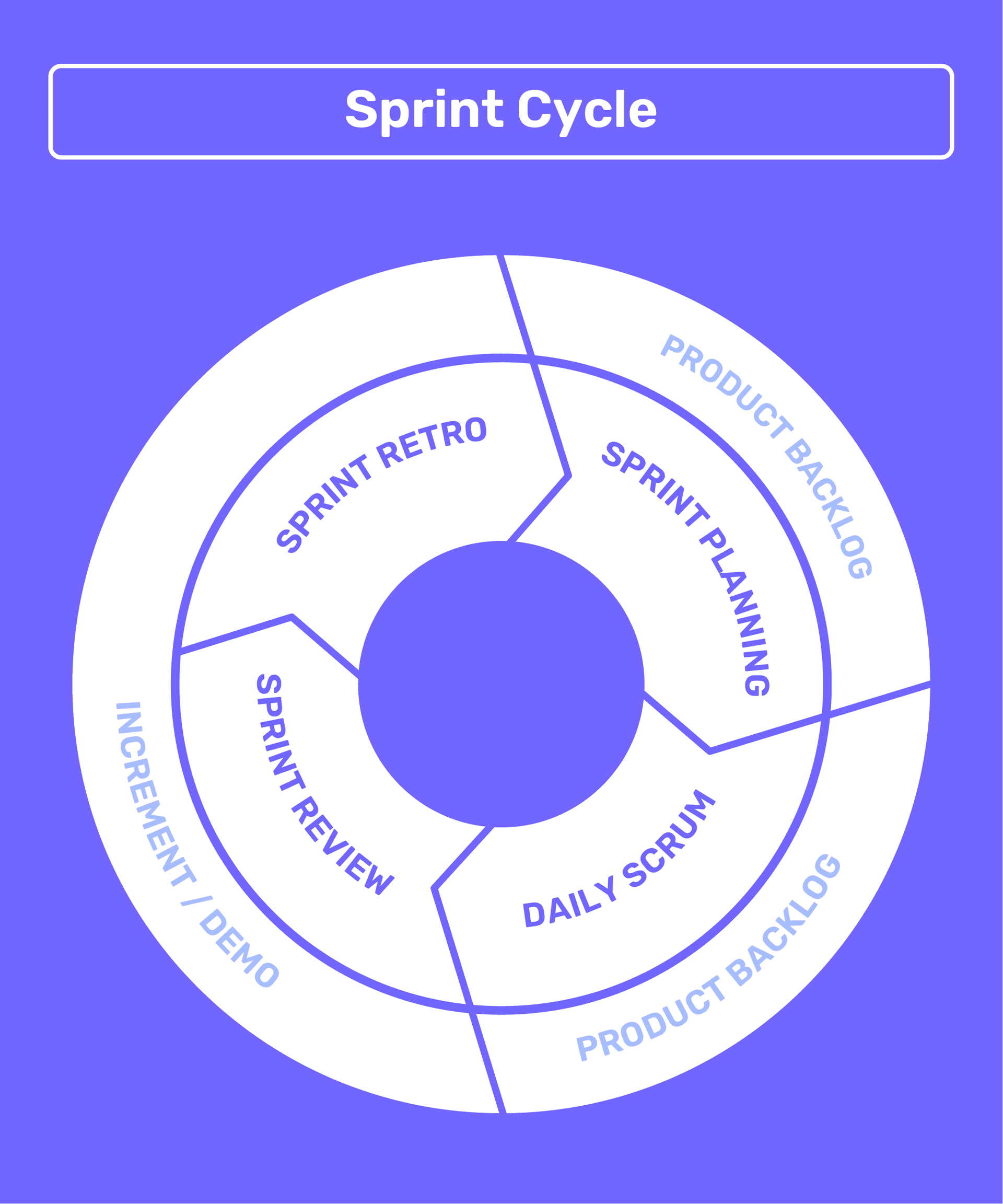
When it comes to software development, Scrum is considered to be the most commonly applied Agile framework. It’s characterized by particular practices and concepts that are divided into Roles, Time Boxes, and Artifacts. Scrum is also distinguished by having the roles of Product Owner and Scrum Master. They’re in charge of assembling and managing the whole Scrum team that includes programmers, designers, Quality Assurance staff, and testers.
Two-weeks sprints make an essential part of the Scrum framework. They serve as special mechanisms to deliver working solutions fast and adjust the initial plans, making sure they respond to any relevant changes.
Kanban
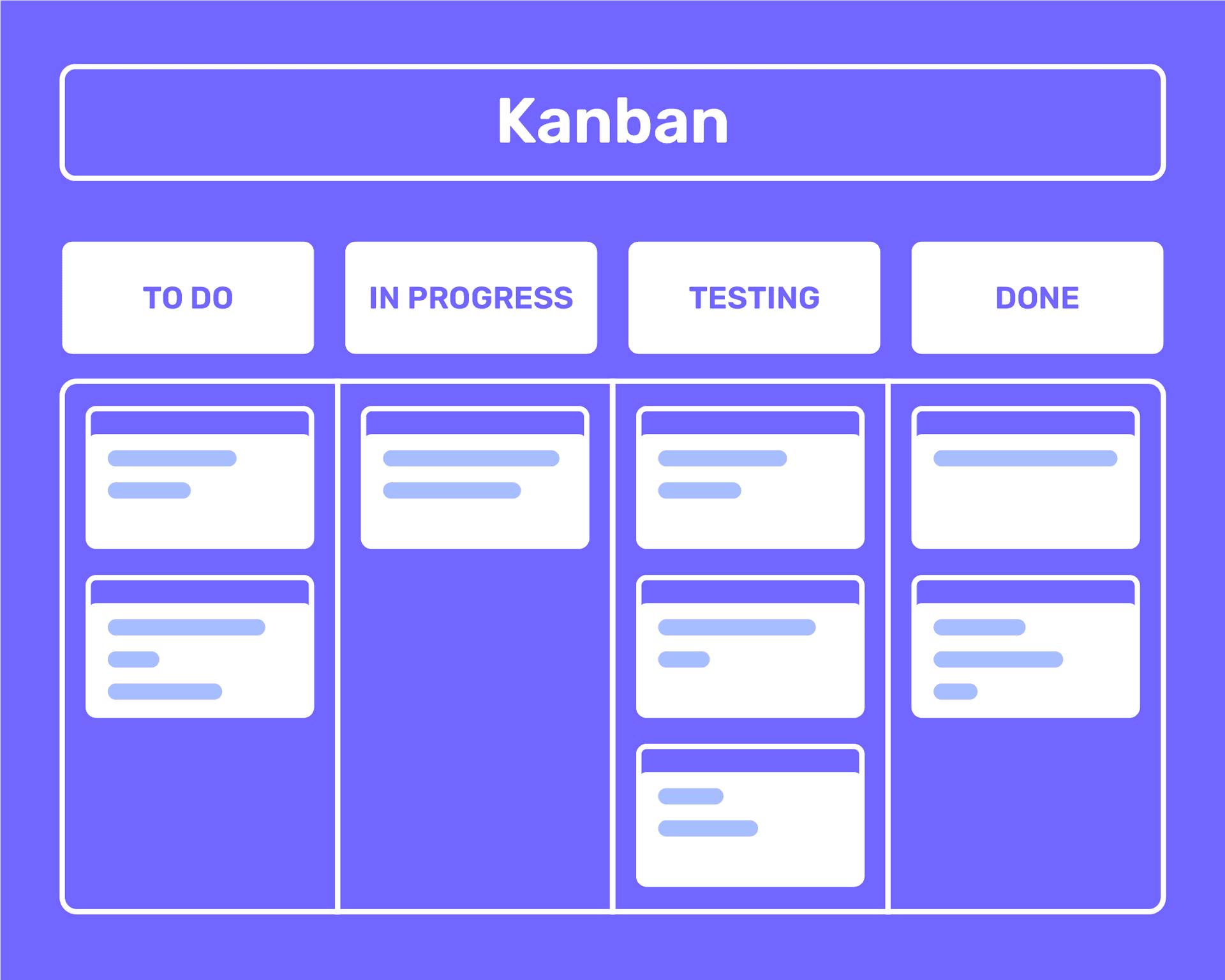
Here’s a framework that serves as a workflow visualization system, when cards get digitized and positioned on the board. When items are represented visually, each team member clearly sees at what stage every process is.
As a rule, the Kanban board has 4 key states:
-
To Do;
-
In Progress;
-
Testing;
-
Done.
While Scrum sprints are made to divide the development process into pieces, the Kanban approach serves to prioritize an uninterrupted work and the delivery flow. DevOps teams prefer to implement the Kanban framework, as it places emphasis on continued delivery and smooth integration.
Extreme Programming (XP)

Extreme Programming (XP) isn't considered to be a traditional framework of Agile software development lifecycle. The thing is that it pays more attention to tech aspects of development activities. XP is designed to implement particular practices, not organizational or management elements.
Thanks to its practices that involve pair programming, weekly and quarterly cycles, continuous integration, test-first programming, and others, Extreme Programming ensures clear communication, simplicity, and valuable feedback. The given Agile framework is characterized by constantly changing software requirements and a small co-located team of experts. XP instruments allow automated unit and function testing.
Feature-Driven Development (FDD)
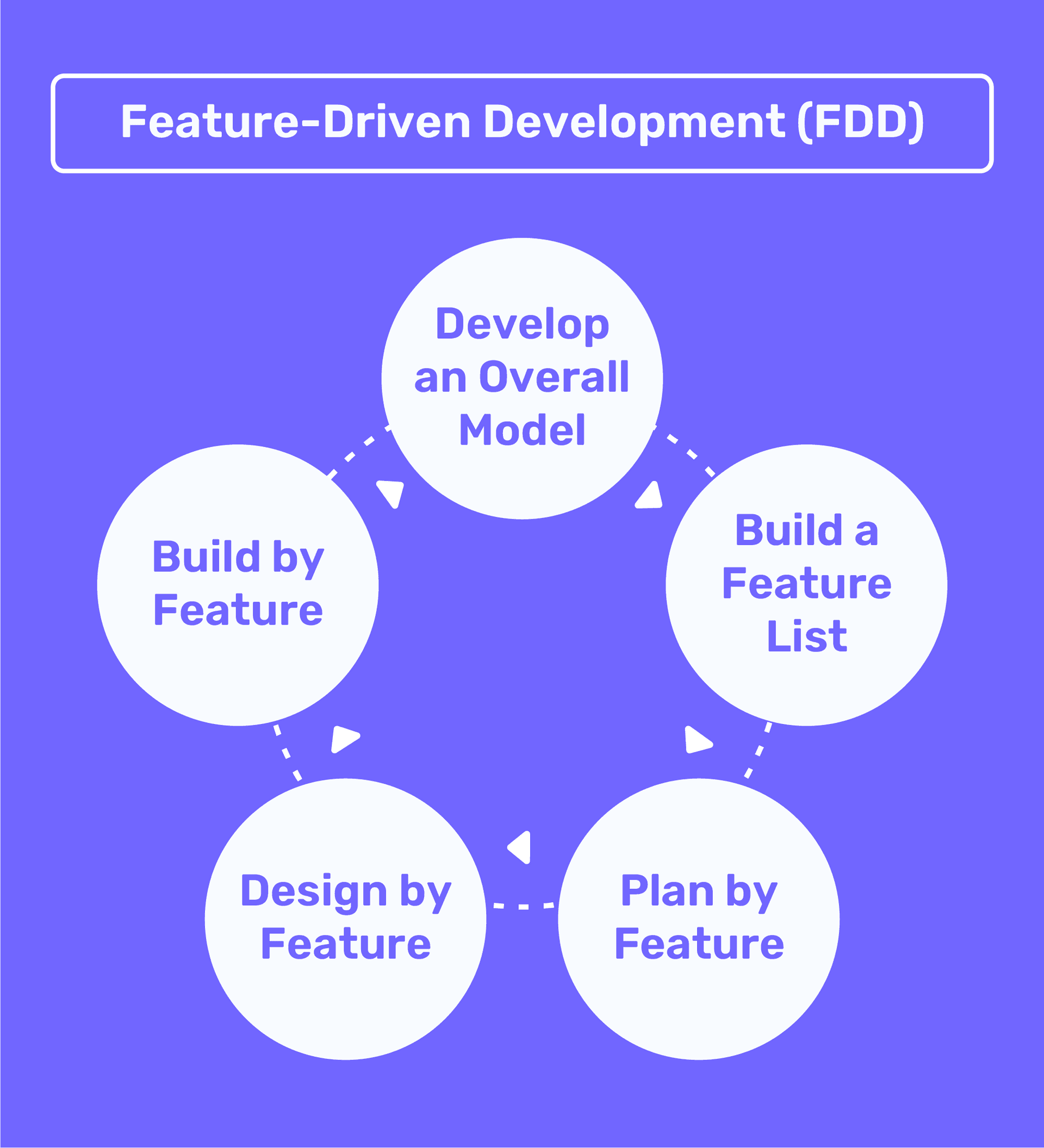
Here, the main focus is placed on completing features. The FDD project cycle shall cover the development of an overall model, creating the list of features, by-feature planning, designing, and building. Such an approach sees features more like Scrum stories, and not as traditional software functionality.
The Feature-Driven Development framework is more suitable for big teams that have pre-determined development requirements. When it comes to small projects, it doesn’t make much sense to go for FDD.
Dynamic Systems Development Method (DSDM)
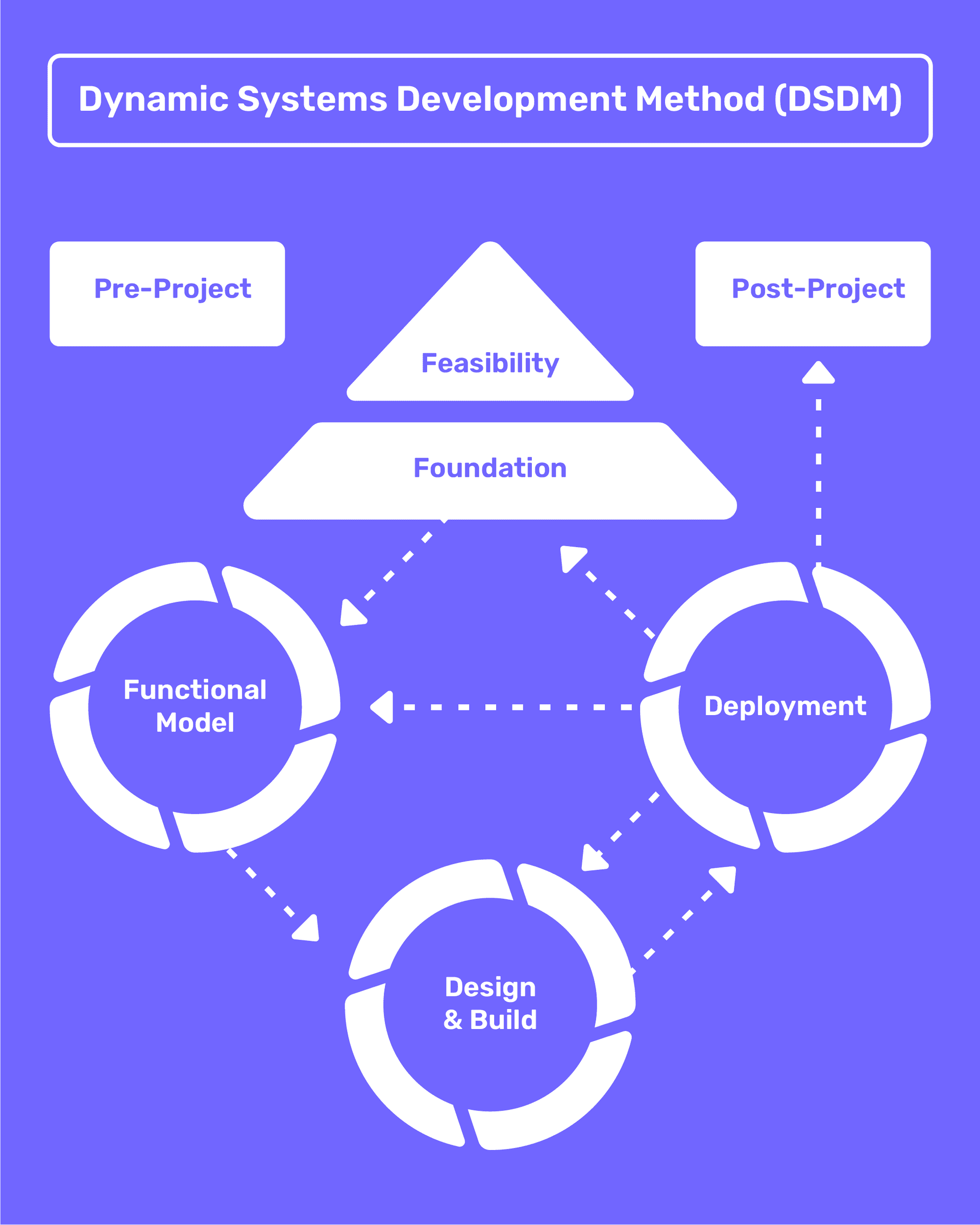
Dynamic Systems Development Method is meant to provide extra governance and discipline to the software development process. DSDM implies every project to be aligned to specifically determined tactical goals, and strive to promptly deliver business benefits.
The presented Agile framework has 7 main principles:
-
On-time delivery;
-
Iterative development;
-
Priority to quality;
-
Control demonstration;
-
Focus on business needs;
-
Collaboration;
-
Clear and regular communication.
Dynamic Systems Development Method studies the business and project feasibility. It takes a good care of design and build iteration, and covers implementation.
Adaptive Software Development (ASD)

The Adaptive Software Development framework represents a more iterative evolution of the Rapid Application Development approach, which we’ll discuss next. ASD is a scheme that concentrates on heavily integrated customer feedback. The mentioned framework is designed to involve that feedback in multiple stages of the development process.
The Adaptive Software Development approach is applied to encourage so-called emergence, which represents unscheduled newly-appeared features and directions.
Rapid Application Development (RAD)
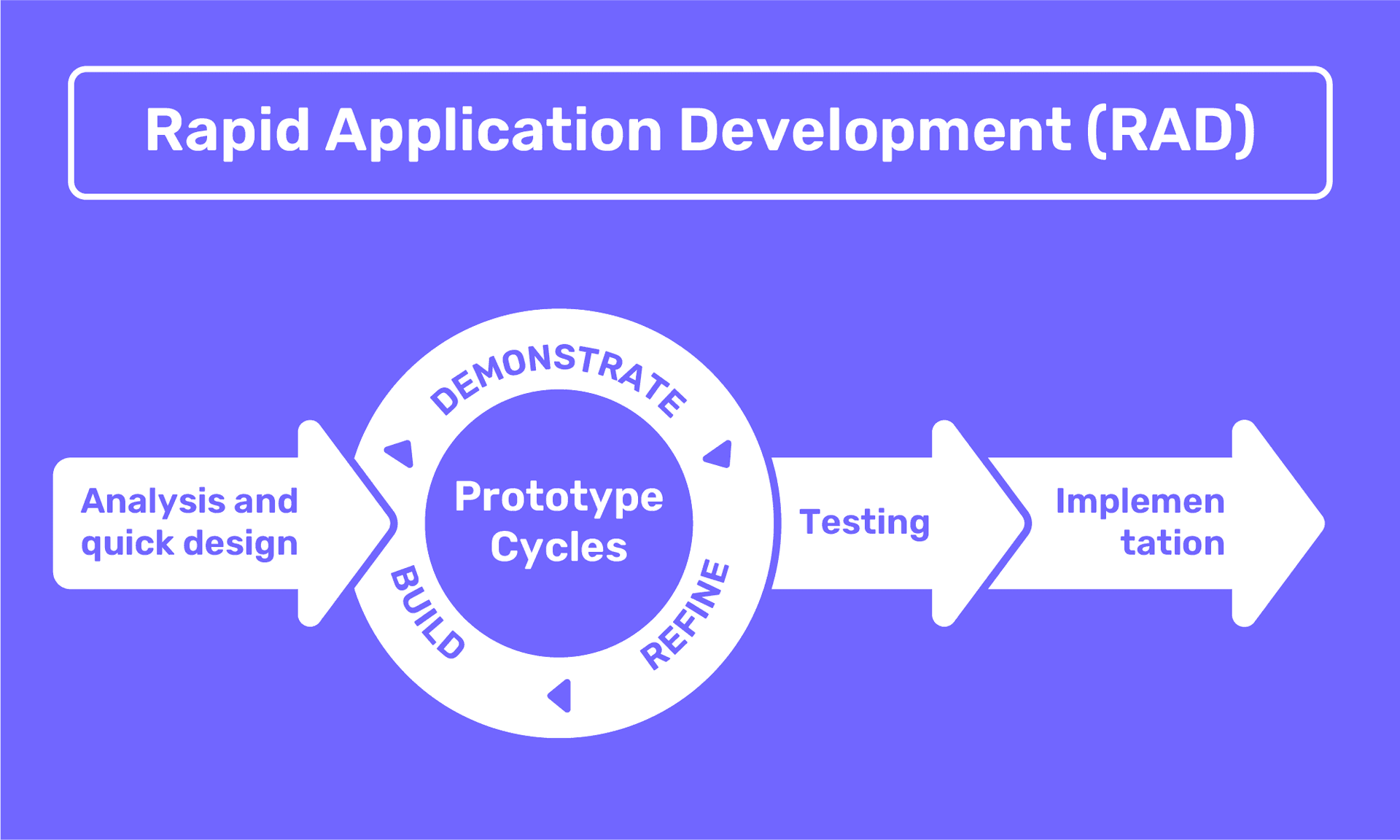
Rapid Application Development framework puts more emphasis on ongoing software projects and user feedback, paying not that much attention to strict plan pursuing. RAD methodology defines requirements, builds prototypes, and absorbs feedback to effectively finalize the product. The given approach ensures high development speed and cost-efficiency.
When it comes to Rapid Application Development, clients are always there at each stage of the development process, giving developers the opportunity to regularly show project progress. Such a framework allows the development team to feel more confident that future product owners will be satisfied with the finalized digital solution. Moreover, dedicated tools could be integrated to encourage fast prototyping, development, and feedback solicitation.
Crystal

The Crystal framework is made to focus on individuals and their interactions, so it’s not about instruments or processes. The implementation of the mentioned approach gives teams the opportunity to find their own ways, intended to streamline relevant workflows. The Crystal methodology appreciates the uniqueness of every IT project, allowing the team of specialists to determine what instruments will better meet the requirements and successfully tackle the work.
The Crystal software development method doesn’t recognize universal strategies and approaches. Owing to its guidelines, development teams make their own decisions regarding the processes and strategies to respond to project unique needs.
Scaled Agile Framework (SAFe)
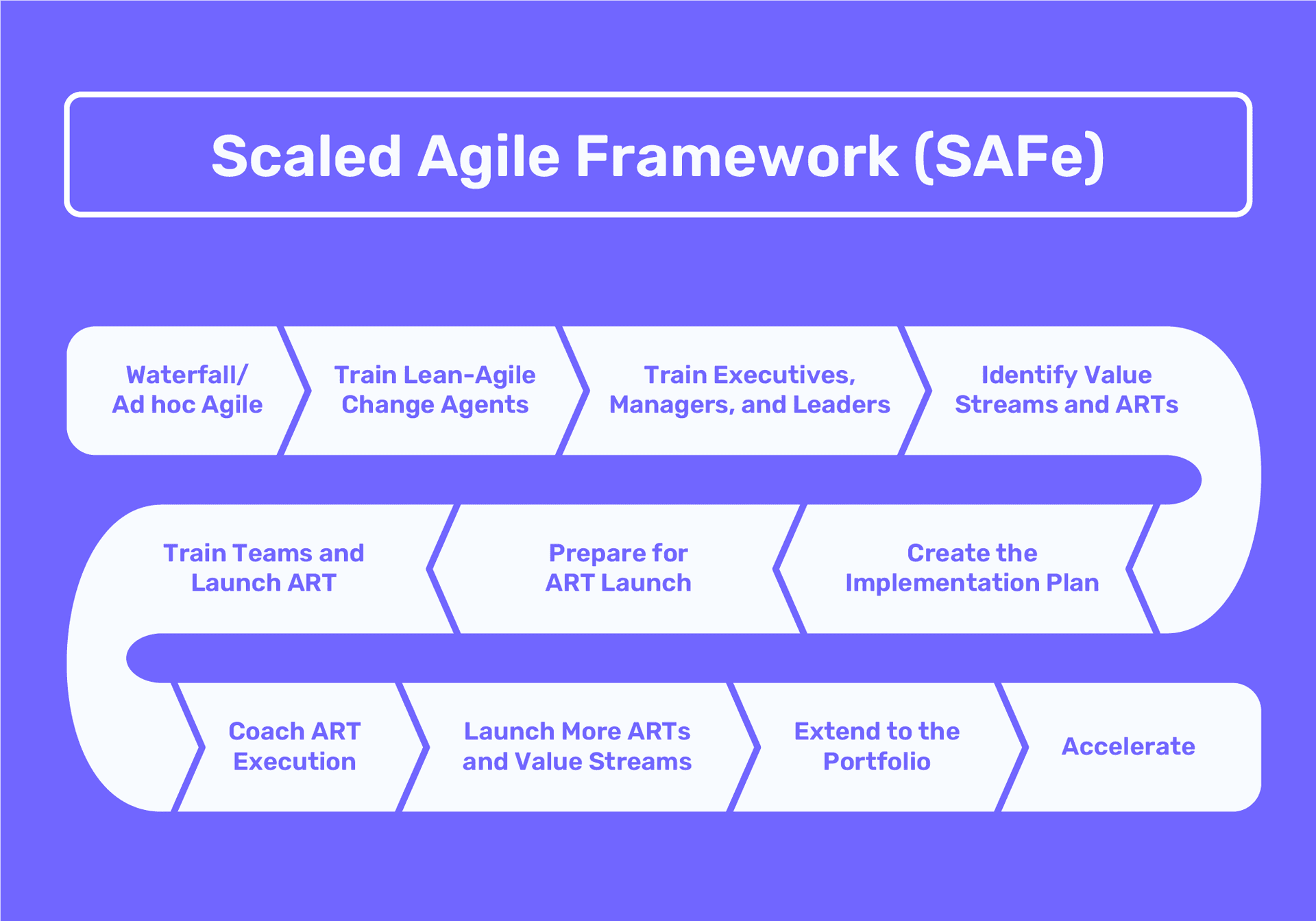
The Scaled Agile Framework represents the best choice when it comes to large-sized projects which involve several Agile teams. SAFe serves to support alignment, cooperation, and successful software delivery through a big number of Agile teams. This approach was made based on agile software development, lean product development, and systems thinking.
SAFe applies systems thinking and implies an economic view of the project. It visualizes and limits Work in Process, reduces batch sizes, and manages queue lengths.
Agile Software Development Process
All the Agile process models are built on the iterative principle. When one iteration finishes, the development team shall proceed to the following phase till all applicable requirements are satisfied. Stakeholders and final users are expected to be engaged in the process to provide valuable feedback and make sure the final solution responds to their expectations. Agile software development lifecycle covers the below stages:
- Analysis and Requirement Definition
Future product owners create a list of main requirements. The task of the development team is to analyze relevant aspects to figure out the core features and remove those functionality that won’t be appreciated by the target audience. - Design
The dedicated team shall take care of the interface and architecture, taking into account the key project requirements. Programming languages and tools shall be chosen accordingly. Designers build UI mockups. Further, the Product Manager might ask developers to adjust the initial version of the design, if required. - Development
After the architecture and UI/UX design are taken care of, it’s time to get down to the development. This phase implies building the solution according to the agreed requirements. As a rule, development takes the greatest time, because this stage is the heart of every project. - Testing
Quality assurance staff shall conduct comprehensive tests to make sure the solution operates as it should and responds to earlier implemented changes. QA tests result in the corresponding report. With every subsequent script, the testing process turns more challenging, as it shall cover more aspects, say, functionality, system integration, user acceptance, etc. - Deployment
When all bugs are fixed in accordance with the testing report, the software gets deployed on the servers. Now users can give it a try. In some cases, at this point people can only test the beta version of the software. - Feedback
The support staff collect first feedback to see customer satisfaction with a new digital product. It’s critical not to ignore this stage since it provides essential data on what could be done (say, what features, improvements should be added, and eliminate errors) to make people enjoy the solution more.
The System Demo is a key event at the end of each Iteration that provides a comprehensive overview and gathering of the new Features that have been implemented by all Agile Release Train (ART) software development teams in the last Iteration. It gives ART an objective measure of progress during the Program Increment.
Advantages of Flexible Agile Development for Product Owners
-
Quick Product Delivery. Thanks to an Agile software development methodology, the development process starts fast, which allows one to come up with a working solution after a few interactions. This enables the final digital product to be created and launched quicker, providing prompt ROI.
-
Reduced risk of failure. Customers are closely involved in each of the development phases, meaning developers have pretty good chances that the final audience will enjoy the software. Agile methods imply regular communication between product owners and developers. Such an approach builds trust and ensures process transparency.
-
Conformity with product owner’s expectations. The development team takes business requirements, carefully analyzes and turns them into test cases, user stories, and acceptance criteria. This is how developers get a clear understanding of the future product, allowing them to build it as the product owner expects.
-
Accurate predictions. Each iteration has a limited duration. This gives the possibility to precisely estimate the costs of the following scope of work and its timeframes. That’s an approach for product owners to calculate the price of every feature they’d like to implement.
-
High quality software. Extensive QA testing tools allow the final product to be of top quality. Moreover, the solutions could be upgraded and scaled as required with the least effort.
-
Efficient development process. All activities that make part of the Agile software development cycle turn out to be more effective since there’s no such thing as long-term planning. Additionally, no need to write full documentation either. An Agile methodology avoids the implementation of features that won’t bring any value to the business.
Wrapping up
As you can see, Agile software development offers multiple benefits for developers and product owners since such methodology implies continuous client involvement and close communication between the parties concerned. Agile methods allow making changes into the work scope whenever required, and the whole development process won’t be affected. The only essential point here is to partner with a professional development team that has necessary expertise to effectively realize your ideas.
We at Agilie implement the Agile methodology of software development and take advantage of the Scrum framework while implementing the projects. Scrum is a means to provide flexibility to production, ensuring any changes to the project could be made at any time. Talk to the Agilie experts now.